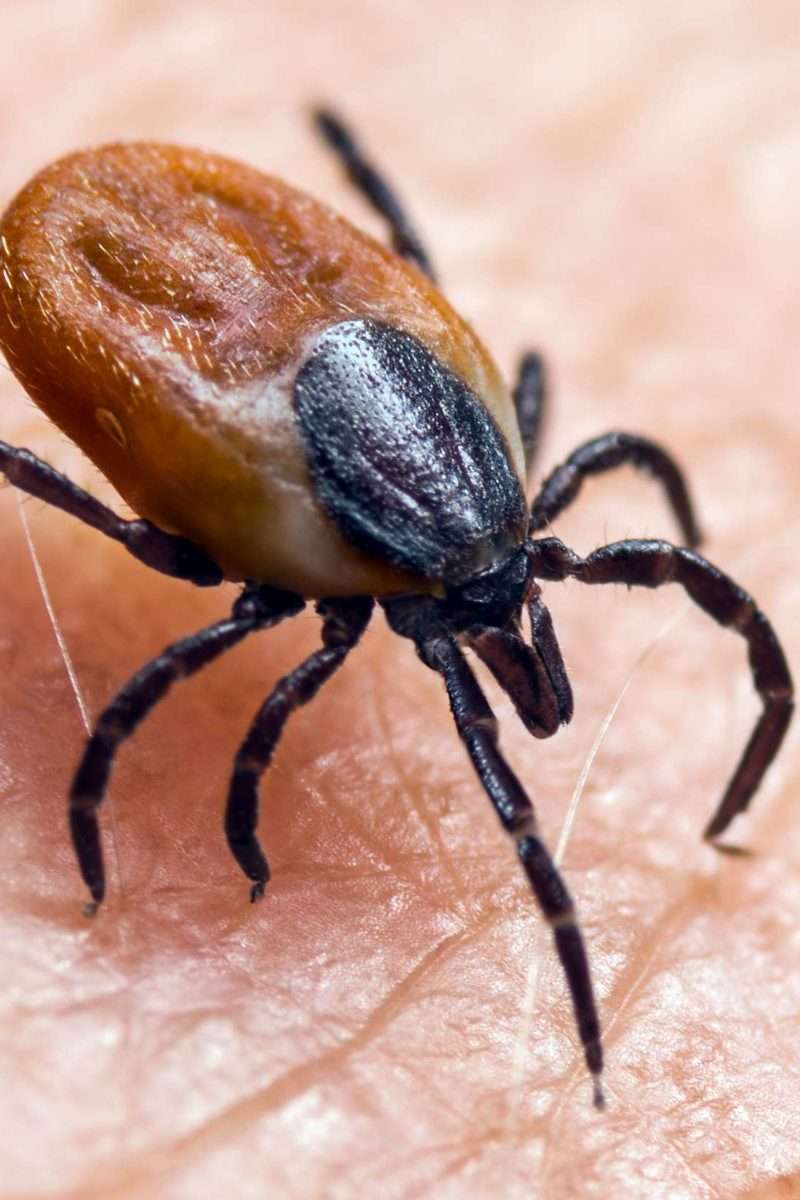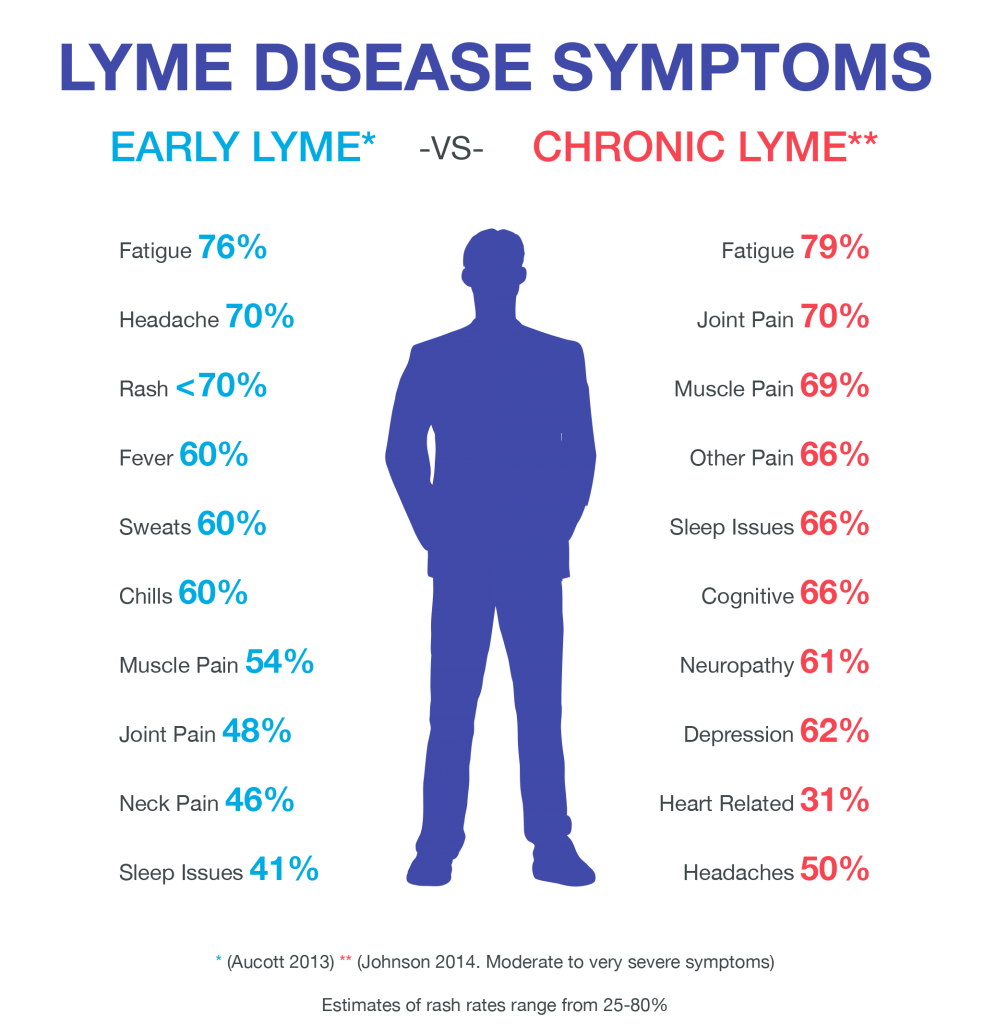Some Chronic Lyme Disease Symptoms
As mentioned, chronic Lyme disease consists of a broad cluster of physical, cognitive, and psychiatric symptoms. Some of these symptoms are much more common, while others almost never occur, but can be deadly. But even the less severe symptoms, such as chronic fatigue and pain, can lead to drastic changes in quality of life for chronic Lyme patients.
Chronic Lyme survivors have reported experiencing the following symptoms for months to years after infection:
- Intermittent fevers, chills, and sweats
- Chronic inflammation
- Numbness and tingling in the limbs
- Dizziness and shortness of breath
- Heart palpitations and irregular heartbeat
- Anxiety and paranoia
- Multiple-chemical sensitivities
Chronic Lyme disease can be linked to deadly symptoms, such as Lyme carditis .
According to Lymedisease.org, studies consistently show that chronic Lyme disease patients have poorer quality of life than those with other chronic diseases. One of their own studies showed that 75% of surveyed patients reported at least one symptom as severe or very severe.
What Are The Treatments For Lyme Disease
A two-week course of antibiotics is the recommended treatment for early Lyme, usually Doxycycline or Amoxicillin. However, providers can extend treatment to 3 or 4 weeks in more complex cases. The NIH is conducting studies on chronic Lyme in search of more effective treatments. For now, many chronic Lyme patients have success with low-dose antidepressants, diet and lifestyle changes and alternative therapies in addition to antibiotics.
What Are The Second Stage Signs And Symptoms Of Lyme Disease
The symptoms of second stage, early disseminated, Lyme disease can be difficult to attribute. Symptoms include severe fatigue, fever, pain, intermittent weakness and achiness of the muscles and joints, numbness in arms and legs, vision changes, and cognitive dysfunction such as short-term memory difficulties and problems multitasking. These symptoms are not specific for Lyme disease and can make the diagnosis of second stage Lyme disease very challenging.
More recognizable Lyme disease nervous system manifestations include facial paralysis , or meningitis with severe headache and stiff neck. Notable cardiac manifestations include passing out or feeling faint from an abnormally slow heart rate, irregular heart palpitations, or unexplained difficulty tolerating exercise. Meningitis and carditis are both potentially serious Lyme disease conditions and warrant immediate medical attention.
Also Check: How Do You Test A Tick For Lyme Disease
Signs And Symptoms Of Untreated Lyme Disease
Seek medical attention if you observe any of these symptoms and have had a tick bite, live in an area known for Lyme disease, or have recently traveled to an area where Lyme disease occurs.
Untreated Lyme disease can produce a wide range of symptoms, depending on the stage of infection. These include fever, rash, facial paralysis, and arthritis.
The appearance of the erythema migrans rash can vary widely.
- Fever, chills, headache, fatigue, muscle and joint aches, and swollen lymph nodes may occur in the absence of rash
- Erythema migrans rash :
- Occurs in approximately 70 to 80 percent of infected persons
- Begins at the site of a tick bite after a delay of 3 to 30 days
- Expands gradually over several days reaching up to 12 inches or more across
- May feel warm to the touch but is rarely itchy or painful
- Sometimes clears as it enlarges, resulting in a target or bulls-eye appearance
- May appear on any area of the body
- Does not always appear as a classic erythema migrans rash
Swollen Knee
- Severe headaches and neck stiffness
- Additional EM rashes on other areas of the body
- Arthritis with severe joint pain and swelling, particularly the knees and other large joints.
- Intermittent pain in tendons, muscles, joints, and bones
- Heart palpitations or an irregular heart beat
- Episodes of dizziness or shortness of breath
- Inflammation of the brain and spinal cord
Links with this icon indicate that you are leaving the CDC website.
How Is Lyme Disease Diagnosed

A healthcare provider will diagnose Lyme disease based on symptoms, physical findings and whether or not you’ve been in an area populated by infected ticks.
Many people dont remember or know that theyve been bitten by a tick. This is because the tick is tiny, and its bite is usually painless.
Your provider will confirm the diagnosis using a blood test. If your first blood test is negative for Lyme disease, you won’t need another test. If the first test is positive or equivocal, your provider will conduct the test again. You have to have two positive results to be diagnosed with Lyme disease.
Read Also: East Lyme Water And Sewer
Dos And Donts Of Getting Help
If you think you may have this syndrome, experts suggest these tips:
Donât assume. Tell your doctor your symptoms, and let her check you.
Donât rush to a specialist. For an accurate diagnosis, start with a primary care doctor, says Eugene Shapiro, MD. He’s a professor of pediatrics, epidemiology, and investigative medicine at Yale School of Public Health.
Do take your antibiotic as prescribed. Even if you feel better, continue the course. Itâs 4 weeks of medications at most. Some experts believe stopping the drugs before your prescription ends may cause symptoms to linger.
Do find experts who can help your symptoms. Ask your doctor if it would be worth your while to visit naturopaths, traditional Chinese medicine doctors, psychologists, or other experts. Many medical centers have complementary and alternative medicine experts on site.
Chronic Lyme Disease Vs Ptlds
The terms chronic Lyme disease and Post-Treatment Lyme Disease Syndrome are sometimes used interchangeably. However, PTLDS is slightly more restrictive, referring to patients who have received treatment for Lyme disease but go on to experience Lyme disease symptoms. It does not include those who received a misdiagnosis or delayed diagnosis and have developed chronic symptoms of Lyme disease before receiving any kind of treatment.
The CDC defines PTLDS as generalized and/or recurring pain, fatigue, and cognitive difficulties that last for more than 6 months after treatment. These mirror symptoms associated with chronic Lyme disease, with or without treatment.
Don’t Miss: What Are The Chances Of Getting Lymes Disease
Late Lyme Disease Symptoms
How To Avoid Tick Bites
To reduce the chance of being bitten:
- cover your skin while walking outdoors and tuck your trousers into your socks
- use insect repellent on your clothes and skin products containing DEET are best
- stay on clear paths whenever possible
- wear light-coloured clothing so ticks are easier to see and brush off
Read Also: How Long Does Lyme Disease Take To Show Symptoms
Lyme Disease Symptoms Also Occur In Other Diseases
Many Lyme symptoms, such as fatigue, cognitive impairment, joint pain, poor sleep, mood problems, muscle pain, and neurological presentations also occur in other diseases. Hence, the symptoms of Lyme disease significantly overlap those of chronic fatigue, fibromyalgia, rheumatoid arthritis, multiple sclerosis, Parkinsons disease, ALS, depression and Alzheimers disease. Many Lyme patients report being misdiagnosed with a different condition before being properly diagnosed with Lyme disease.
Also Check: What Are Tests For Lyme Disease
Who’s At Risk Of Lyme Disease
The risk of getting Lyme disease is higher:
- for people who spend time in woodland or moorland areas
- from March to October because more people take part in outdoor activities
It’s thought only a small proportion of ticks carry the bacteria that cause Lyme disease. Being bitten doesn’t mean you’ll definitely be infected. However, it’s important to be aware of the risk and speak to a GP if you start to feel unwell.
You May Like: Urgent Care Lyme Disease Test
Legal Mandates To Cover Unproven Treatments
The state of Connecticut, meanwhile, enacted a law on June 18, 2009, “to allow a licensed physician to prescribe, administer or dispense long-term antibiotics for a therapeutic purpose to a patient clinically diagnosed with Lyme disease.” The states of Rhode Island, California, Massachusetts, New Hampshire, Vermont, New York, Maine, and Iowa have similar laws.
Massachusetts and Rhode Island have laws mandating insurance coverage for long-term antibiotic therapy for Lyme disease when deemed medically necessary by a physician. In 1999 Connecticut had passed a similar, though somewhat more restrictive law.
Who Is At Risk For Lyme Disease

Anyone can get a tick bite. But people who spend lots of time outdoors in wooded, grassy areas are at a higher risk. This includes campers, hikers, and people who work in gardens and parks.
Most tick bites happen in the summer months when ticks are most active and people spend more time outdoors. But you can get bitten in the warmer months of early fall, or even late winter if temperatures are unusually high. And if there is a mild winter, ticks may come out earlier than usual.
Recommended Reading: Old Lyme Beach Cottage Rentals
Signs You Might Have Chronic Lyme Disease
Ticks suck quite literally.
After latching onto the succulent bits of your anatomy, like your armpits, butt crack, thighs, behind your ears, or any other place they fancy, they’ll feed on you like any other parasite. The fact that ticks may also carry a nasty surprise in the form of the bacterium Borrelia Burgdorferi which will give you Lyme Disease is now, fortunately, pretty well known. Knowing all about Lyme Disease doesn’t, however, necessarily prevent you from getting it, or from having it for a long time before finally realizing that there’s something seriously wrong.
“Seven of my coworkers have had serious Lyme Disease,” Alaine, a warden in a nature reserve, told me, continuing:
“One was in a wheelchair for a year or so, another had to quit her job due to the neurological effects of chronic Lyme Disease, and a third had badly swollen joints and also had to go on sick leave. Yet another coworker who had Lyme Disease developed debilitating memory problems that presented like dementia. All these people were physically fit, mostly young, and active before being diagnosed. Prolonged antibiotics do improve the situation, but many have had flare-ups. When Lyme Disease plays up, it makes functioning as a warden extremely difficult.”
Tucking her pants into her socks and wearing wellies, covering up, and using DEET-based bug repellent haven’t helped Alaine avoid Lyme Disease. She shares:
Acute Vs Chronic Lyme Disease
When we talk about Lyme disease, we must differentiate between acute and chronic Lyme disease. Acute Lyme disease is a short-term or recent infection. Chronic Lyme disease is a long-term on-going one. When caught early, within the first few days to weeks of a tick bite and infection, acute Lyme disease can be treated with a course of antibiotics.
Holistic health professionals can also offer various supplements and nutritional strategies to help resolve acute Lyme disease. While there is still a risk of long-term health issues, usually, acute Lyme disease can be treated effectively.
One of the most commonly believed symptoms of acute Lyme disease is a flat, circular rash with a bulls eye, however, not all people notice a bulls eye rash. In fact, according to newer data, it is only the minority who notice a bulls eye rash which may lead to people not seeking treatment, misdiagnosis, a lack of early treatment, and the risk of chronic Lyme disease.
Other symptoms of acute Lyme disease include fatigue, joint and muscle pain, headaches, sleep issues, fever, concentration issues, and swollen lymph nodes. This can be easily mistaken with the flu or often written up as stress, fatigue, or psychosomatic symptoms.
You May Like: Lyme Disease What Is It
Unexplained Pain And Other Sensations
Some people with Lyme may have sharp rib and chest pains that send them to the emergency room, suspecting a heart problem 00090-7/abstract%20â³ rel=ânofollowâ> 27).
When no problem is found, after the usual testing, the ER diagnosis is noted as an unidentified musculoskeletal cause.
You can also have strange sensations like skin tingling or crawling, or numbness or itchiness 00090-7/abstract%20â³ rel=ânofollowâ> 27).
Other symptoms have to do with cranial nerves.
- Ear-ringing . Tinnitus can be a nuisance, especially at bedtime when it seems to get louder as youre trying to fall asleep. About 10 percent of people with Lyme experience this (
- Hearing loss. One study reported that 15 percent of Lyme patients experienced loss of hearing .
- Jaw pain or toothaches that are not related to actual tooth decay or infection.
Summary:
Later Symptoms Of Lyme Disease
More serious symptoms may develop if Lyme disease is left untreated or is not treated early. These can include:
- pain and swelling in the joints
- nerve problems such as numbness or pain in your limbs
- memory problems
- difficulty concentrating
Some of these problems will get better slowly with treatment. But they can persist if treatment is started late.
A few people with Lyme disease go on to develop long-term symptoms similar to those of fibromyalgia or chronic fatigue syndrome. This is known as post-infectious Lyme disease. It’s not clear exactly why this happens. It’s likely to be related to overactivity of your immune system rather than continued infection.
Also Check: Tahiti Nail Spa East Lyme
Chronic Lyme Disease: Symptoms Causes And Coinfections
Are you experiencing fatigue, headaches, joint pain, muscle aches, sleep issues, memory and concentration troubles, neurological issues, body pains, or other chronic symptoms without a known explanation? You may have chronic Lyme disease.
Chronic Lyme disease is increasingly prevalent and a very serious health issue. It is caused by Borrelia burgdorferi bacteria transmitted by infected ticks. When Lyme disease is not diagnosed and properly addressed during the acute phase during the first weeks, it can turn chronic leading to countless symptoms and health complications.
Unfortunately, testing is not reliable and the conventional medical community is not equipped to adequately address this rampant health issue. Fortunately, there are Lyme-literate healthcare professionals, like myself, who can help you to get the right diagnosis. You can overcome chronic Lyme disease following some natural supports strategies and using a 6-month protocol.
In this article, you will learn what Lyme disease is and the difference between acute and chronic Lyme disease. You will understand the symptoms of chronic Lyme disease. I will explain what co-infections you may encounter if you have chronic Lyme disease. I will discuss the problems with standard testing methods and offer more reliable testing alternatives. I will offer some natural support strategies to get started with.
Is Chronic Lyme Disease Real
Physicians have been baffled by people who continue to suffer arthritis, brain fog, fatigue and other symptoms long after they have completed treatment. This confusion may be caused in part by the insistence of experts at the National Institute of Allergy and Infectious Diseases that:
Lyme disease can usually be successfully treated with three to four weeks of antibiotic therapy.
A recent estimate contradicts the idea that chronic lyme disease is rare. Experts from Lyme country recently wrote that as many as two million people could suffer from PTLDS by 2020 .
The authors note:
Although antibiotic therapy cures most LD patients, a significant proportion of patients continue to suffer persisting symptoms that can derail normal life. These include chronic pain, neurological sequelae such as cognitive dysfunction, refractory arthritis and debilitating fatigue. Whether the persistence of symptoms is attributable to LD is the subject of impassioned debate.
Animal studies have revealed evidence of the spirochete that causes Lyme disease up to a year after antibiotic treatment . These authors acknowledge that 10% to 20% of patients treated according to national guidelines will end up with post-treatment Lyme disease syndrome.
If there are 300,000 cases of Lyme disease each year, that means 30,000 to 60,000 people could end up with chronic Lyme disease. We do not consider that rare!
The authors of this article conclude:
You May Like: Can Lyme Disease Cause Blood In Urine
How Chronic Lyme Is Treated
Because chronic Lyme disease is still poorly understood in the medical community, there is currently no definitive treatment protocol offered through mainstream medicine. Thankfully, however, many people with chronic Lyme are reporting success in resolving their ongoing symptoms by retraining their brains.
Before we delve into how to support chronic Lyme recovery from a neurological perspective, lets discuss common traditional and alternative treatment options and the advantages and disadvantages of each approach.
The Chance Of Getting Lyme Disease

Not all ticks in England carry the bacteria that causes Lyme disease.
But it’s still important to be aware of ticks and to safely remove them as soon as possible, just in case.
Ticks that may cause Lyme disease are found all over the UK, but high-risk places include grassy and wooded areas in southern and northern England and the Scottish Highlands.
SINCLAIR STAMMERS/SCIENCE PHOTO LIBRARY https://www.sciencephoto.com/media/263611/view
Ticks are tiny spider-like creatures that live in woods, areas with long grass, and sometimes in urban parks and gardens. They’re found all over the UK.
Ticks do not jump or fly. They attach to the skin of animals or humans that brush past them.
Once a tick bites into the skin, it feeds on blood for a few days before dropping off.
Also Check: Royall Lyme Where To Buy